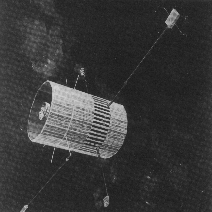|
|
IMP 7

The IMP 7 spacecraft was launched on 23 September 1972 and placed into a
roughly circular orbit (apogee ~ 200,000 km) on 12 October 1972. The
16-sided drum-shaped satellitewas 157 cm high and 135 cm in diameter. The
spacecraft was powered by solar cells and a chemical battery. The spin axis
was normal to the ecliptic, with a spin period of 1.3 seconds. The instrument
configuration was the same as for IMP 6, but the satellite spin
rates, data integration intervals, and duty cycles differed. The differences
resulted in IMP 7 being more effectively omnidirectional, allowing for a less
ambiguous interpretation of the spectra. Data collection for the gamma-ray
instrument on board began on 14 October 1972. The spacecraft was turned off
on 31 October 1978.
The gamma-ray monitor instrument consisted of a 2.25 inch diameter x 1.5
inch thick CsI(Tl) crystal surrounded by a plastic scintillator. The
plastic served as a particle rejector. The crystal was viewed by a single
photomultiplier. The monitor was on continuously except for the passage
through the magnetotail, which occurred every 4.14 days. In addition to
monitoring the rates of total intensity, particle intensity, and gamma-ray
intensity, energy spectra of the incident gamma-rays were measured in 14
channels. The gain of the system was cycled through 4 positions, with changes
being made roughly every week for purposes of in-flight calibration. Thus,
some data were taken with a 69-1150 keV energy range, while other data were
taken with a 53-88 keV range.
The IMP 7 gamma-ray data were collected in 2 modes: a continuous
accumulation of data for 40.9 s into 14 energy channels and a 40.9 s
collection mode during which data are collected only when the satellite
rotation caused it to face the Sun.
In the first 14 months of operation, the IMP 7 gamma-ray detector recorded
9 confirmed bursts. All 9 events had event-averaged photon number spectra
from 100-1100 keV, and were statistically consistent with each having the
same shape.
[Gallery]
[Publications]
[All Missions]
[by Time]
[by Energy]
Page authors: Lorella Angelini Jesse Allen
HEASARC Home |
Observatories |
Archive |
Calibration |
Software |
Tools |
Students/Teachers/Public
Last modified: Thursday, 26-Jun-2003 13:48:18 EDT
|


